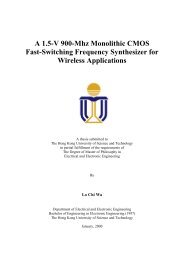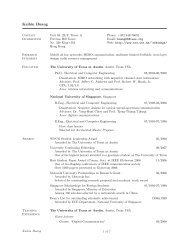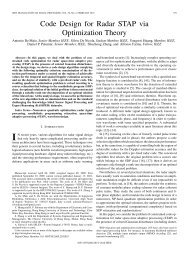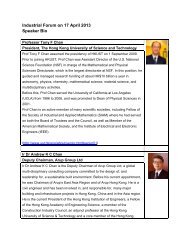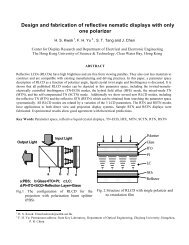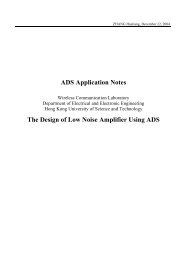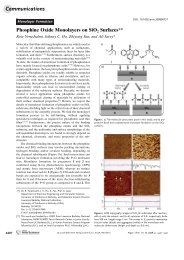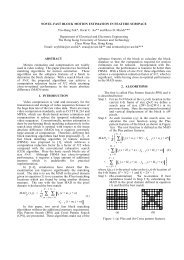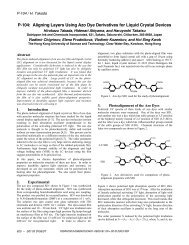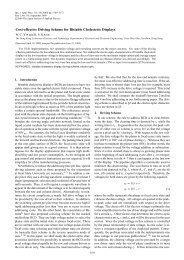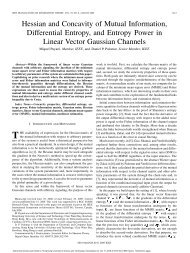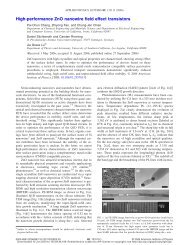CMOS CURRENT REFERENCE CIRCUIT DESIGN MP4-06
CMOS CURRENT REFERENCE CIRCUIT DESIGN MP4-06
CMOS CURRENT REFERENCE CIRCUIT DESIGN MP4-06
Create successful ePaper yourself
Turn your PDF publications into a flip-book with our unique Google optimized e-Paper software.
<strong>MP4</strong>-<strong>06</strong><strong>CMOS</strong> <strong>CURRENT</strong> <strong>REFERENCE</strong><strong>CIRCUIT</strong> <strong>DESIGN</strong>Supervised by: Prof. Philip K.T. Mok Yang Fan 03739133
INTRODUCTIONIn this project, a couple of current reference circuits were studied and implemented.Current reference is a generated current source with stablecurrent supply relatively insensitive to external variations like temperature,process and voltage. It is essential for applications like operationalamplifier and data converter bias circuits, which are commonly used inanalog Integrated Circuit design.One of the designs uses the bangap characteristic of semiconductor material,the other one utilizes the difference on drain-source voltages of NMOSand PMOS as the general methods of curvature cancellation. The generatedvoltages were converted to stable currents via a voltage-to-currentconverter. The designs were also tested for process variations under Fourcornermodels.System Block Diagram The system consistsof a bandgapvoltage referenceand a voltage-tocurrentconverter.The later part canfurther breakdown into an operationalamplifierand current compensationsubcircuit.Principle of BVR It takes two generatedcurrents, oneproportional to absolutetemperature(PTAT), the othercomplementary toabsolute temperature(CTAT), addthem together tominimize the effectof temperature coefficient.The sensitivity ofparameters withregard to temperatureis measured inppm/ºC, part permillion per degree.The boxed curve isset at referencetemperature of27ºC. The positionof the dot has nearzero changeTemperature Coefficient Curves The two dimensionalmodels representfour possibleextreme conditionscorrespondingto speed ofMOSFETs:Worst Zero (WZ),Worst Power (WP),Worst One (WO)andWorst Speed (WS).The Four-corner Models
<strong>DESIGN</strong>Bandgap Voltage ReferenceVoltage Reference Utilizing Gate-Source VoltageCurrent Reference Circuit with the Bandgap ReferenceThe first block (M1-M5, MN, MP) is the∆V GS configuration.The gate-source voltagesof MN and MPcancel each other primarilyto provide astable reference voltage.The subsequentblocks are nearlyidentical to those ofdesign I.The first block consistsof M4-M8 is asimple bandgap voltagereference; thesecond block (M9-M28) is the V-I converter,in which M11-M14, M16 make anop amp; the currentfrom M33 is retrievedand adjusted by thelast block.Current Reference Circuit with ∆V GS Voltage Reference
RESULTSTemperature Coefficient of Design ITemperature Coefficient of Design IIPerformance with Process Variation (Design I)Performance w/ Process Variation (Design II)COMPARISONParameters Sansen et al. [1] Badillo [2] Design I Design IITechnology (not applicable) 0.25-µm 0.35-µm 0.35-µmTemperature 0°C -80°C -40°C -150°C -30°C -100°C -30°C -100°CI ref 0.774µA±4% 4.95µA±7% 37.4µA±0.4% 46.1µA±1.1%TC 375ppm/°C 368ppm/°C 28.8ppm/°C 88.4ppm/°C[1] W.M.Sansen, F.O.Eynde, M.Steyaert, “A <strong>CMOS</strong> Temperature-Compensated Current Reference”, IEEE Journal ofSolid-State Circuits,Vol.23, No.3, pp.821-824, June 1988.[2] D. A. Badillo,“1.5V <strong>CMOS</strong> Current Reference with Extended Temperature Operating Range”, Proc. The 2002 IEEEInternational Symposium on 2002 IEEE International Symposium on Circuits and Systems (ISCAS’02), Scottsdale,USA, May 2002.




